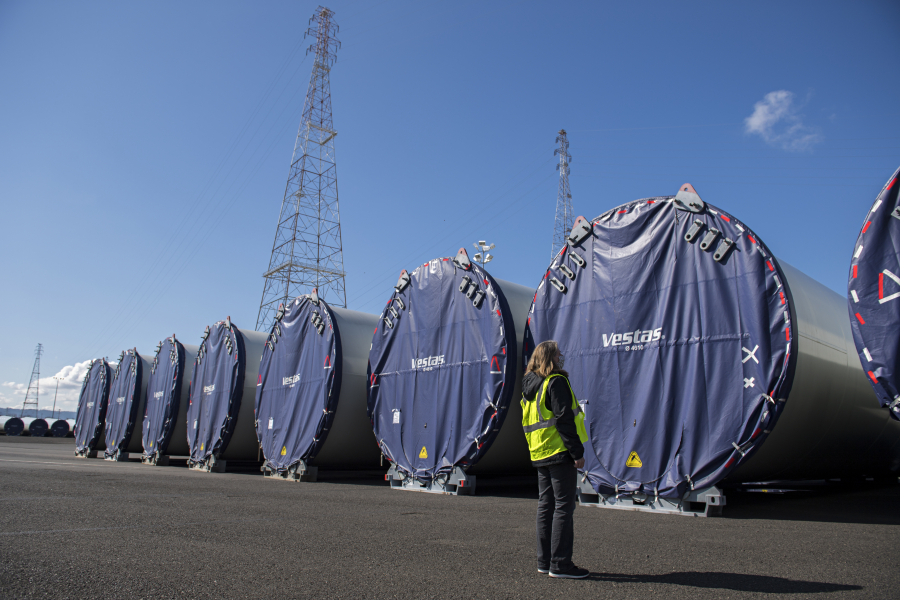Fewer ships docked, fewer trains rolled through and some of the biggest regular import and export commodities hit significant speed bumps during the pandemic.
By most metrics, 2020 was a tough year for the Port of Vancouver – but it was also the most profitable year in the port’s history.
The port released its year-end financial summary last week, detailing a record revenue total of $50.36 million for 2020, which represents a more than 15 percent gain over 2019 despite the numerous COVID-19 challenges.
Port officials attributed the surprise success to the port’s diverse lineup of bulk and oversized cargo, which allowed it to dodge some of the biggest pandemic impacts. The single biggest saving grace was wind energy, according to chief commercial officer Alex Strogen.
The port has worked for several years to establish itself as an import hub for wind energy components, and the effort has led to a series of increasingly large shipments (both in terms of their quantity and physical size), culminating in a record number of shipments throughout 2020.
“The wind really helped us overcome a lot of our challenges here at the port this year, because we saw some of our other commodities really struggle over the course of the year,” Strogen said. “Having a really diverse cargo mix really, quite frankly, saved our rear ends.”
Wind advantages
Wind components that pass through the port are typically trucked to farms in Eastern Washington or Oregon, but Strogen said 2020 marked the first time that the port received components bound for Canada’s Alberta and Saskatchewan provinces.
There are other major ports that are closer to those destinations, but Strogen said the Vancouver port enjoys a competitive advantage for outsized cargo because it boasts relatively easy access to Interstate 84 without too many tunnels, overpasses or tight turns for truck drivers to contend with while hauling 77-meter-long blades.
The biggest wind import competitors are actually ports along the Gulf Coast, such as the Texas cities of Houston and Galveston, he said, which are farther away but offer similarly easy routes to get the blades onto the freeway system.
In those cases, the Vancouver port’s advantage is Terminal 5, a largely undeveloped space at the western end of the port property. A single cargo ship can bring in dozens of blades all at once, so the port needs to have room to store them for weeks or months while they’re trucked out one at a time.
“We moved almost 3,000 wind components through here in 2020, and we needed truly every inch of Terminal 5 to accommodate it,” Strogen said.
Wind import shipments are planned far in advance, he said, so 2020 was set to be a huge wind year from the start. The fact that the wind shipments were able to pick up the financial slack when other port commodities were held back by the pandemic was mostly down to luck.
“Three years ago when we started working on this business, we didn’t know a pandemic was coming, but the timing was perfect,” Strogen said.
Part of what makes the wind components so lucrative is that moving them anywhere is a very labor-intensive process, he added. Vacuums and conveyor systems can transfer grain products en masse, but the turbine blades have to be delicately unloaded one by one using the port’s two mobile harbor cranes.
Other commodities
The Port of Vancouver generally focuses on bulk products or cargo with unique dimensions, a niche that also helped during the pandemic, according to communications director Theresa Lang. Air traffic and container shipping operations were among the hardest-hit worldwide, she said, and the Port of Vancouver doesn’t handle either of those types of cargo.
That’s not to say the port’s other commodities were unaffected. Total vessel calls dropped from 397 in 2019 to 360 in 2020, and rail car traffic fell to 63,310 from 69,632 the year before. Total tonnage fell from 8.285 million metric tons in 2019 to 7.368 last year, according to a year-end summary published by the port.
Import volumes decreased by about 23.97 percent from 2019, which the port attributed mainly to decreases in steel slab and fertilizer traffic. Export volumes, which make up about 86 percent of the port’s total operations, remained “relatively flat,” according to the report.
Vancouver is the biggest import destination for Subaru vehicles on the West Coast, but shipments ground to a halt during the first few months of the pandemic.
“We went two months without having a single vessel arrive with a single vehicle discharged,” Strogen said.
Grain exports were slower at the beginning of the year, which Strogen pointed to as one of the reasons for the lower annual count of railcars passing through the port. The slowdown was due to a relatively strong dollar at the time, he said, making it tougher for U.S. exporters to compete with other sellers in the international market.
The playing field leveled out in the summer of 2020, he said. Grain traffic also began to pick up after the United States and China signed an initial trade deal in January 2020, according to Augusto Bassanini, CEO of United Grain, which operates an export terminal at the port.
The lower ship count is also partially explained by an ongoing trend toward larger vessels on the Columbia River, Strogen said. So while the average number of ships has been declining in recent years, that doesn’t necessarily translate into a decline in overall cargo volume.
Despite the wind energy windfall and the struggles of the other cargos in 2020, Strogen said the port’s future still lies mainly in bulk commodities because they offer more long-term stability than the wind industry, which tends to be cyclical. The past year’s wind performance was a lucky outlier, he said, one that the port is going to be unlikely to match in the future.
“You chase as much as you can and maybe you get 20 percent, 30 percent,” he said. “We won everything. We won it all. But how often does that happen?”




